NJFSC Chapter #44S..........PHS Affiliate #1A..........APS Affiliate #95 |
Society & Member's Galleries....
As we continue to add more galleries, some will be for public display while many will be reserved for members access only.
Featured Covers Gallery
February 2016 Issue of the NJPH Journal THE FIRST U.S. WARSHIP SUNK ON 7 DECEMBER 1941:
NEW JERSEY-BUILT BATTLESHIP, USS OKLAHOMA (BB 37)1
By: Captain Lawrence B. Brennan, U.S. Navy (Retired). Member, NJPHS
“Oklahoma failed to fire a single shot in anger
during two world wars.” 2
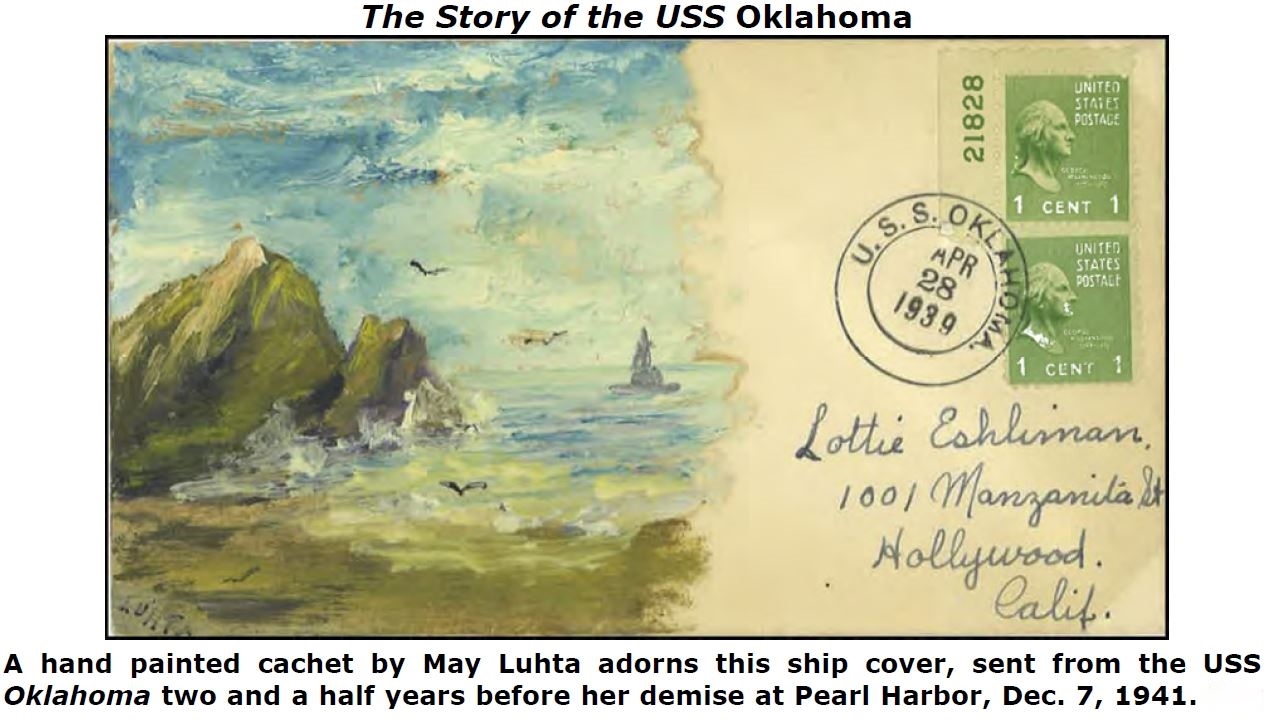
USS Oklahoma (BB 37) was built by New York Shipbuilding in Camden, New Jersey.
She was the first U.S. warship sunk in the Pacific during World War II and was violently destroyed
with massive loss of life. She was struck on the port side by as many as nine aircraft-launched
torpedoes, and capsized within 12 minutes. The battleship sank at Pearl Harbor on the morning of
Sunday, 7 December 1941, with the loss of 429 officers and men; suffering the second greatest
number of casualties that morning. Together with USS Arizona (BB 39) more than 60% of the
fatalities that morning were suffered by these two ships on Battleship Row.
Beginnings:
Oklahoma was ordered on 4 March 1911 during the Taft Administration. She was the
second of a pair of Nevada-class battleships, the U.S. Navy’s first super-dreadnoughts and oilburning
ships. Oklahoma was the only US warship ever named for the 46th state.3
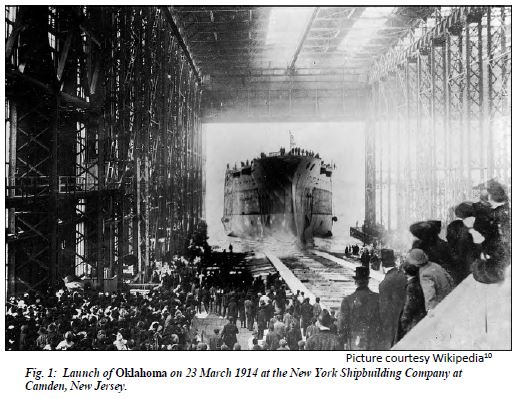
Oklahoma’s keel was laid down on 26 October 1912. She was launched a year and a half
later on 23 March 1914. The launch was preceded by an invocation – the first in half a century for
a U.S. warship. On the night of 19 July 1915, a year plus after launching, large fires were
discovered underneath the forward main turret, the third in a U.S. battleship in less than a month.
The fire had been caused by “defective insulation” or a mistake made by a dockyard worker. This
casualty delayed the battleship’s completion so that she was not commissioned until 2 May 1916
at Philadelphia Navy Yard, with Captain Roger Welles, U.S. Navy in command.
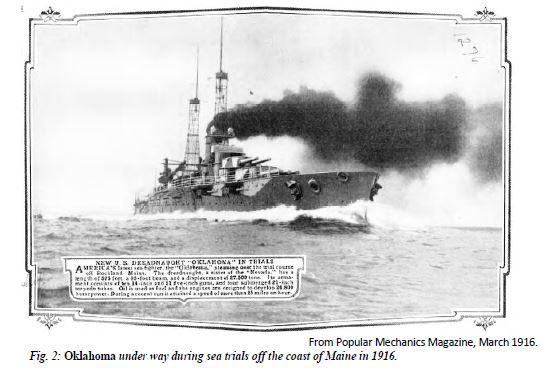
The First Years
Following commissioning, the ship remained on the East Coast. After the United States
declared war on the German Empire in April 1917, Oklahoma was unable to join Battleship
Division Nine, which had been sent to support the Grand Fleet in the North Sea, due to a lack of
oil available in the United Kingdom. In 1917, she underwent an upgrade of her guns, including
installation of anti-aircraft defense, and repositioning of her 5 inch guns. While berthing
conditions were cramped, the sailors enjoyed multiple educational opportunities. They also spent
their time on athletics, including boxing, wrestling and rowing meets with the crews of USS Texas
(BB 35) and the New Jersey-built tug USS Ontario (AT 13). These competitions led to fleet-wide
establishment of athletic teams by the 1930s.
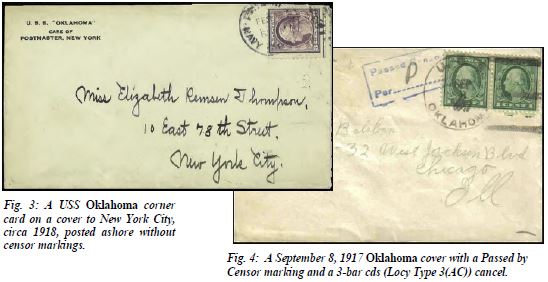
World War I
Oklahoma enjoyed a relatively pacific war. On 13 August 1918, she was assigned to
Battleship Division Six under Rear Admiral Thomas S. Rodgers, and departed for Europe with her
sister ship, Nevada. On 23 August they rendezvoused with destroyers USS Balch (DD 50), USS
Conyngham (DD 58), the New Jersey-built USS Downes (DD 45), USS Kimberly (DD 80), USS
Allen (DD 66), and USS Sampson (DD 63), 275 nautical miles west of Ireland‘s west coast, before
steaming for Berehaven Harbor, where they waited 18 days before Utah arrived. The division
remained at anchor, tasked to protect American convoys sailing in the area, but was only underway
once in 80 days. Just before the end of hostilities, on 14 October 1918, while under command of
Captain McVay, she escorted troop ships into an English port, returning on 16 October. Then, the
ship conducted her initial drills at anchor in nearby Bantry Bay.
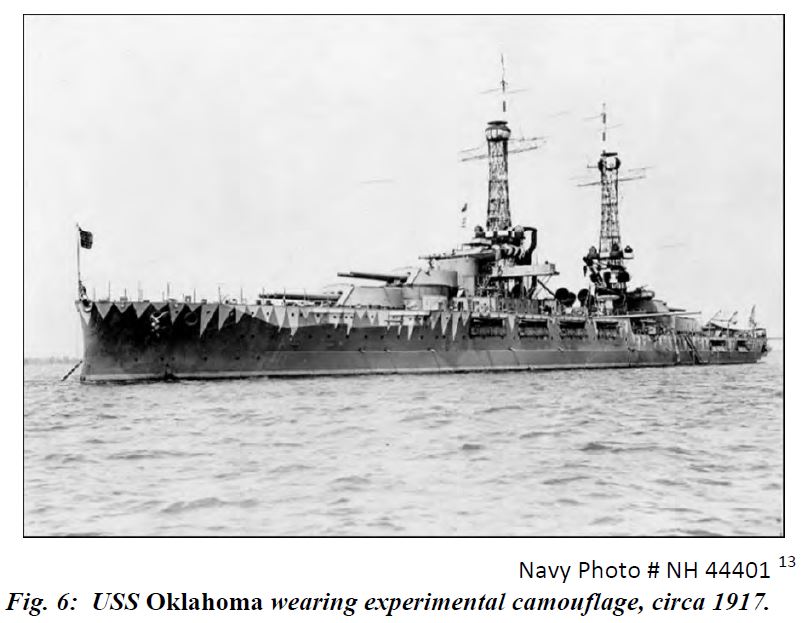

Convoying President Wilson and Between the Wars
Oklahoma sailed for Portland, England on 26 November 1918, and was joined there by
Arizona on 30 November, Nevada on 4 December, and ultimately Battleship Division Nine. These
ships served as a convoy escort for the former German liner, USS George Washington (TT 31081)
carrying President Woodrow Wilson to peace negotiations in France following WWI. She then
spent early 1919 conducting winter battle drills off the coast of Cuba, and on 15 June 1919, she
returned to Brest, escorting Wilson on his second trip, and returned to New York on 8 July. A part
of the Atlantic Fleet for the next two years, Oklahoma was overhauled, and early in 1921, she
proceeded to the west coast of South America for combined exercises with the Pacific Fleet, before
returning later that year for the Peruvian Centennial.

Oklahoma then joined the Pacific Fleet and participated in a training cruise. The largest
collection of U.S. battleships since the Great White Fleet departed San Francisco on 15 April 1925
and arrived in Hawaii on 27 April, where they conducted war games. The fleet then departed for
Samoa, visiting Australia and New Zealand before returning home. In early 1927, she transited
the Panama Canal and joined the Scouting Fleet. In November 1927, Oklahoma entered
Philadelphia Navy Yard for an extensive overhaul: the addition of eight 5 inch guns; an aircraft
catapult was installed atop of one of the after turrets; she was substantially up-armored with antitorpedo
bulges and an additional two inches of steel on her armor deck. Her beam was expanded
to 108 feet, the widest in the U.S. Navy and just within the width of the Panama Canal.


Oklahoma returned to the West Coast in June 1930 for fleet operations through spring 1936.
That summer, she carried midshipmen on a European training cruise. The cruise was interrupted
with the outbreak of civil war in Spain, as Oklahoma steamed to Bilbao, Spain arriving on 24 July
1936 to rescue American citizens and refugees whom she carried to Gibraltar and French ports.
She returned to Norfolk on 11 September, and departed for the West Coast.


Oklahoma was based at Pearl Harbor from 29 December 1937; only twice did she return to
the mainland, once to have anti-aircraft guns and armor added to her superstructure at Puget Sound
Navy Yard in February 1941 and once to have armor replaced at San Pedro in mid-August 1941.
On 23 August, after encountering rough seas, she had to deviate to San Francisco, the closest navy
yard with an adequate dry-dock, where she remained until mid-October.

Pearl Harbor
Figure 14 below is an aerial view of “Battleship Row” moorings at Pearl Harbor on the
southern side of Ford Island, 10 December 1941, showing damage from the Japanese raid three
days earlier. In upper left is the sunken USS California (BB 44), with smaller vessels clustered
around her. Diagonally, from left center to lower right are: USS Maryland (BB 46), lightly
damaged, with the capsized USS Oklahoma (BB 37) outboard. A barge is alongside Oklahoma,
supporting rescue efforts. USS Tennessee (BB 43), lightly damaged, with the sunken USS West
Virginia (BB 48) outboard. USS Arizona (BB 39), sunk, with her hull shattered by the explosion
of the magazines below the two forward turrets. Note dark oil streaks on the harbor surface,
originating from the sunken battleships.7
On Friday, 5 December 1941, Oklahoma returned to Pearl Harbor; it was her last day
underway. Then, on Sunday, 7 December 1941, the first of four waves of the Japanese air strikes
commenced more than an hour after USS Ward (DD 139)8 reported that she had attacked a
Japanese midget submarine after searching for two hours near the harbor entrance.9 Oklahoma,
moored outboard of USS Maryland (BB 46), was fatally wounded during the first of four waves
of air attacks that morning. While the crew was ordered below for protection from the attack and
to their battle stations, many of the men were trapped when Oklahoma capsized.


Oklahoma’s Commanding Officer, Captain Howard D. Bode, had departed the ship just
before the attack began and stayed on board Maryland. Oklahoma was sunk by at least six
torpedoes and multiple bombs. She capsized within 12 minutes as a result of lack of watertight
integrity following the torpedo hits on her port side. Oklahoma’s bilge inspection covers had been
removed for a scheduled routine inspection the following day (8 December 1941). This precluded
counter flooding to prevent capsizing.12 Her crew abandoned ship but many of the men remained
in the fight, clambering aboard Maryland.

Salvage and Wreck Removal
Wreck removal of Oklahoma commenced on 15 July 1942 under Captain F.H. Whitaker,
U.S. Navy and a team from the Pearl Harbor Naval Shipyard. In 1943 she was righted. Unlike
the other battleships - except Arizona - that were salvaged following Pearl Harbor, Oklahoma was
too heavily damaged to be returned to service. She was decommissioned and stricken on 1
September 1944, a year and a day before the surrender of Japan. Eventually she was stripped of
all remaining armaments and superstructure before being sold for scrap in 1946. The hulk sank in
a storm while being towed from Oahu to a breakers yard in San Francisco Bay on 17 May 1947.15
Oklahoma received a single battle star.

Remaining Artifacts
The National Postal Museum at the Smithsonian houses some remarkable artifacts from
Oklahoma, relating to the attack on Pearl:

“I am well” cards were issued to sailors after the bombing at Pearl, so sailors could let their
families know they were OK. An example is shown in Figure 22.

*This in an abridged version of this article, which appears in full in the February issue of NJPH.
|
______________________________________________
ENDNOTES: |
1 Copyright 2016 by Lawrence B. Brennan. All moral and legal rights reserved. This may not be copied, republished,
or distributed without the express written consent of the copyright holder.
2 Captain Herbert Fox Rommel, Jr., U.S. Navy (1915-2007) commanded five commissioned ships and the Washington
Navy Yard. He was a Turret Captain in Oklahoma
3 This article reproduces information from Wikipedia at https://en.wikipedia.org/wiki/USS_Oklahoma_%28BB-
37%29, which in turn depends heavily on information on the DANFS (Dictionary of American Fighting Ships) site
at http://web.archive.org/web/20070911120713/http://www.history.navy.mil/danfs/o2/oklahoma.htm As DANFS is
a work of the U.S. government, its content is in the public domain, and the text is often quoted verbatim in other
works (including in some cases Wikipedia articles). Many websites organized by former and active crew members
of U.S. Navy vessels include a copy of their ships’ DANFS entries.
4 A Library of Congress Photo http://loc.gov/pictures/resource/ggbain.15699/
5 A Wikipedia photo at https://en.m.wikipedia.org/wiki/File:USS_Oklahoma_BB-37.jpg
6 This scan by Jon Burdett, in the Naval Cover Museum at
http://www.navalcovermuseum.org/wiki/images/7/70/JonBurdett_oklahoma_bb37_19210103.jpg
7 Official U.S. Navy photograph 80-G-387565.
8 She was sunk on 7 December 1944 by a kamikaze.
9 Morison, Rear Admiral Samuel Eliot, History of United States Naval Operations In World War II, Volume III, The
Rising Sun in the Pacific, 1931-April 1942 (Boston: 1948 Little, Brown & Co.) pp. 95-98.
10 Oklahoma History at http://www.okhistory.org/kids/usshistory2
11 Original diagram from http://navsource.org/archives/01/037/013719a.jpg
12 http://web.mst.edu/~rogersda/umrcourses/ge342/Salvage%20of%20USS%20Oklahoma.pdf. It was incredible after
the War Warning of November 1941 to schedule a routine inspection of Oklahoma, or any other combatant vessel.
But that was precisely what was ordered by Vice Admiral William S. Pye, U.S. Navy, Commander, Battle Force,
United States Fleet.
13 Wikipedia article using Nara photo 295984 at https://catalog.archives.gov/id/295984
14 Photo from http://uboat.net/allies/commanders/4343.html
15 Oklahoma History at http://www.okhistory.org/kids/usshistory2
16 From the U.S. Militaria Form blogsite at http://www.usmilitariaforum.com/forums/index.php?/topic/168850-
1941-pearl-harbor-postal-history-post-yours/
|
Past Featured Covers
 |
November 2015 Issue of the NJPH Journal THE HISTORY of the BATSTO Post Office by Arne Englund....The cover is not dated, but as the Batsto Post Office was opened June 28, 1852, and as
mandatory prepayment of postage by U.S. postage stamps was enacted in March of 1855, the
envelope would then date between 1853 and 1855.
Read more..... |
 |
August 2015 Issue of the NJPH JournalStraight Line Post Marks of NJ: Lawrenceville by Robert G. Rose....The U.S. Philatelic Classics Society is in the process of completing an update of the American Stampless Cover Catalog, which was last revised in 1997. That project has been supported by the New Jersey Postal History Society, whose members have
Read more..... |
 |
May 2015 Issue of the NJPH JournalLINCOLN FUNERAL TRAIN PASSES THROUGH NEW JERSEY by Jean Walton
The Civil War ended on April 9, 1865, and only one week later, our 16th President was
dead from an assassin’s bullet. This mourning cover for Lincoln....
Read more..... |
 |
February 2015 Issue of the NJPH JournalSHORT-LIVED NEW JERSEY POST OFFICES
By Arne Englund
New Jersey has had over 900 name-different post offices over the course of time. Of
these, however, 124 were in operation for only a year or less. Another 28 operated for less than
two years..
Read more..... |
 |
November 2014 Issue of the NJPH JournalN.J. LOCAL POSTS: Bayonne City Dispatch
By Larry Lyons
This is the third of a series of articles on New Jersey’s local stamps. Local Posts were established as
early as the 1840’s by enterprising private individuals and companies who carried letters within city
limits – including to and from Post Offices.
Read more..... |
 |
August 2014 Issue of the NJPH Journal AN EARLY BURLINGTON POSTMARKED COVER
By Ed & Jean Siskin
Burlington, New Jersey was founded by two Quaker groups in 1677, five years earlier
than Philadelphia. It was a planned community and the original draft map of the town prepared in 1678, contains many of the same street names that exist today.
Read more..... |
 |
May 2014 Issue of the NJPH Journal NEW JERSEY’S NEGATIVE LETTERED STAMPLESS POSTMARKS by
Robert G. Rose
During the period that domestic stampless mail was permitted ending in 1855, two New Jersey post offices employed negative lettered handstamped postmarks. As a branch of postal
history known as “marcophily,” these markings are avidly collected for their eye-catching
appearance.. Read more..... |
 |
February 2014 Issue of the NJPH Journal BRIDGETON FORERUNNER, 1694 By Ed & Jean Siskin
The excellent articles on the Bridgeton Post Office and its postmasters by Doug D’Avino
started with its first United States post office in 1792. As a prequel to those articles, it is worth
discussing a letter from the Bridgeton area a century earlier. Read more..... |
 |
November 2013 Issue of the NJPH Journal JERSEY CITY AND THE BEGINNING OF BIG TOBACCO By John A. Trosky
P. Lorillard & Company, one of the most iconic names in the tobacco industry in
America, had its beginnings in the New York City area in the mid 17th century. The company
was founded by Pierre Abraham Lorillard, a French Huguenot, in the year 1760. Its small
beginnings Read more..... |
 |
August 2013 Issue of the NJPH Journal UNOFFICIAL REGISTRATION OF NEW JERSEY STAMPLESS COVERS By James W. Milgram, M.D.
From November 1, 1845 to June 30, 1855 there was an unofficial type of Registration of
valuable letters at most post offices within the United States. The first marking is the large blue
“R” applied on receipt at Philadelphia beginning in 1845 Read more.....
|
 |
May 2013 Issue of the NJPH JournalSTAGE OPERATIONS AND THE MAILS IN NEW JERSEY©
By Steven M. Roth (© 2013. Steven M. Roth)
Prior to the Revolutionary War, major travel in the American colonies was restricted
for the most part to the Read more..... |
 |
February 2013 Issue of the NJPH Journal INTENDED FOR THE GRAF ZEPPELIN BUT CARRIED BY STEAMER? A 1929 Jersey City Transatlantic Airmail to Basel Switzerland
by John Trosky
The first decades of the 20th century saw the dawn of a new age in mail transport, airmail. By
the late 1920s Read more..... |
 |
November 2012 Issue of the NJPH Journal LEGISLATIVE FRANKS OF NEW JERSEY by Ed & Jean Siskin
The franking privilege is the right to send and or receive mail free from postage.
Read more..... |
 |
August 2012 Issue of the NJPH Journal HADLEY AIR FIELD, NEW BRUNSWICK. NEW JERSEY by Jim Walker
Early air mail service in the New York area used an assortment of air fields on Long
Island. Hazlehurst Field was the one in use at the commencement of Transcontinental Air Mail
Service in 1924 and was deemed inadequate due to smoke from city industries and ocean fog.
Read more..... |
 |
May 2012 Issue of the NJPH Journal FIVE CENT 1856 STAMP ON COVERS FROM NEW JERSEY by Robert G. Rose
Have you ever fantasized, as have I, of forming a collection of United States
classic stamps used on covers from New Jersey? If so, the task to put such a collection
together would be a real challenge....
Read more..... |
 |
February 2012 Issue of the NJPH Journal A Wonderful Revolutionary Letter by Ed and Jean Sisken
In the Oct-Nov 1988 issue of La Posta, Tom Clarke wrote an article about a wonderful
Revolutionary War cover he had. Dated February 16, 1777, from New Brunswick, New Jersey...
Read more..... |
 |
November 2011 Issue of the NJPH Journal New Jersey Civil War Covers -Wyman the Wizard!
If you were to conduct a detailed review of the 190 Civil War
patriotic covers illustrated in NJPH whole nos. issues 100 and 117, or the
online exhibit of covers shown at NOJEX, you can begin to see the
emergence of some interesting patterns among the covers. An obvious
pattern is that there are several different correspondences represented in
the illustrated covers. Read more..... |
 |
August 2011 Issue of the NJPH Journal New Elizabeth, NJ Marking
ELIZABETHTOWN STAMPLESS POSTMARK ALTERED TO READ “ELIZABETH”!
This newly-discovered Elizabeth postmark falls at the time the name was changed from
Elizabethtown to Elizabeth, and a new handstamp was created from an existing Elizabeth-town
postmark.
Read more..... |
 |
May 2011 Issue of the NJPH Journal Civil War Patriotic Covers from New Jersey.
The cover below is dated Mar. 10 from Bloomsbury, NJ to West Liberty, Ohio, with the imprint of S.C. Rickards, Stationers, 102 Nassau Street, N.Y., and shows one of the rare New Jersey Civil War patriotic images.
Read more..... |
 |
February 2011 Issue of the NJPH Journal A Folded Letter in art - was it from New Jersey?
This painting by Jacques-Louis David, painted in 1821, shows two Bonaparte princesses reading a stampless folded letter from their father, Joseph Bonaparte, brother of Napoleon. Was it written to them from New Jersey?
Read more..... |
 |
November 2010 Issue of the NJPH Journal REVOLUTIONARY WAR COVER
The cover of our most recent journal features this Revolutionary item, from Don Chafetz’s prize-winning exhibit of Morris County Mail Service, 1760 to 1850.
Read more..... |
 |
August 2010 Issue of the NJPH Journal NEW JERSEY ILLUSTRATED LETTER SHEETS
These items were made popular by the nice ones that exist from the California Gold Rush days, and those used during the Civil War, where they depicted contemporary scenes at the top of the letter sheet, the rest of which was then used to write a letter.
Earliest examples usually included an attached sheet and were used as stampless folded letters.
Later ones were more like letterheads, and were sent enclosed in envelopes.
Read more..... |
 |
May 2010 Issue of the NJPH Journal Celebrates the 100th Anniversary of the Boy Scouts of America!
Treasure Island Scout Camp occupies a fifty-seven acre island in the Delaware River between Pennsylvania and New Jersey. The camp is operated by the Cradle of Liberty Council (formerly the Philadelphia Council), Boy Scouts of America. Read more..... |
 |
February 2010 Issue of the NJPH Journal featuring a 1995 cover of the aircraft carrier USS Kitty Hawk, the last of the conventionally-powered US aircraft carriers, decommissioned in 2009.
This great ship served almost 50 years in service of her country.
Read more..... |
 |
November 2009 Issue of the NJPH Journal featuring a Holiday Greetings from Viet Nam
Just before Christmas of 1971, a GI-produced Christmas card was distributed to the troops of the 101st Airborne for them to send home. A hand-made envelope served to carry it home to New Jersey.
As it was late in December, member Jim Walker used a U.S. air mail stamp instead of the usual free frank available to soldiers in combat,
Read more..... |
 |
August 2009 Issue of the NJPH Journal featuring a a Graf Zeppelin cover.
L127 First Trip to the USA in 1928. Special credit to John Trosky for this nice article!
WEB-SITE SPECIAL: an addendum to this article with additional information on an originating 1928 LZ-127 cover from Len Peck!
Read more..... |
 |
May 2009 Issue of the NJPH Journal featuring a DPO cover from Maurer, New Jersey.
A pretty little letter sheet invitation from a local hotel in Maurer (now part of Perth Amboy, Middlesex County), NJ turned up at the Garfield-Perry Show in Cleveland, in JWF (Jim Faber’s) stock. Used in 1905, it is from a community that literally does not exist anymore. The location is now the site of a large “tank farm” belonging to Chevron.Read more..... |
 |
February 2009 Issue of the NJPH Journal featuring a cameo campaign cover.
A December 15, Hoboken, NJ postmarked Embossed Cameo Campaign Envelope produced by William Eaves was offered this March by Robert A. Siegel Auctions featuring a beardless Abe Lincoln. Only a few examples are known. This Hoboken, New Jersey cover hammered on March 25, 2009 for $2600.00 before the 15% buyers premium! Read more..... |
 |
November 2008 Issue of the NJPH Journal featuring a cover of seasonal greeting.
A RFD ”Season’s Greetings” post card, cancelled December 24, 1915 with a Pittstown, NJ postmark, sent by the carrier on Route 2 out of Pittstown to the people along his route. Special thanks to Member Jim Walker for sharing this cover. Read more..... |
Members: One of the benefits of membership is sharing your interests and collections! If you would like to share an interesting single item from your collection, or have multiple items to share - the NJPHS Galleries offer you the opportunity to put your collectibles on center stage. Please e-mail your webmaster about contributing to our on-line Galleries. We can even help you if you do not have a scanner or digital images. Just ask. Remember, we are always looking for articles of interest for the NJPH Journal, and would welcome your contribution whether it's a single page or five page article.
If you are not yet a member, please consider the benefits of joining and the satisfaction you'll get by sharing with your fellow collectors: Become a Member |
